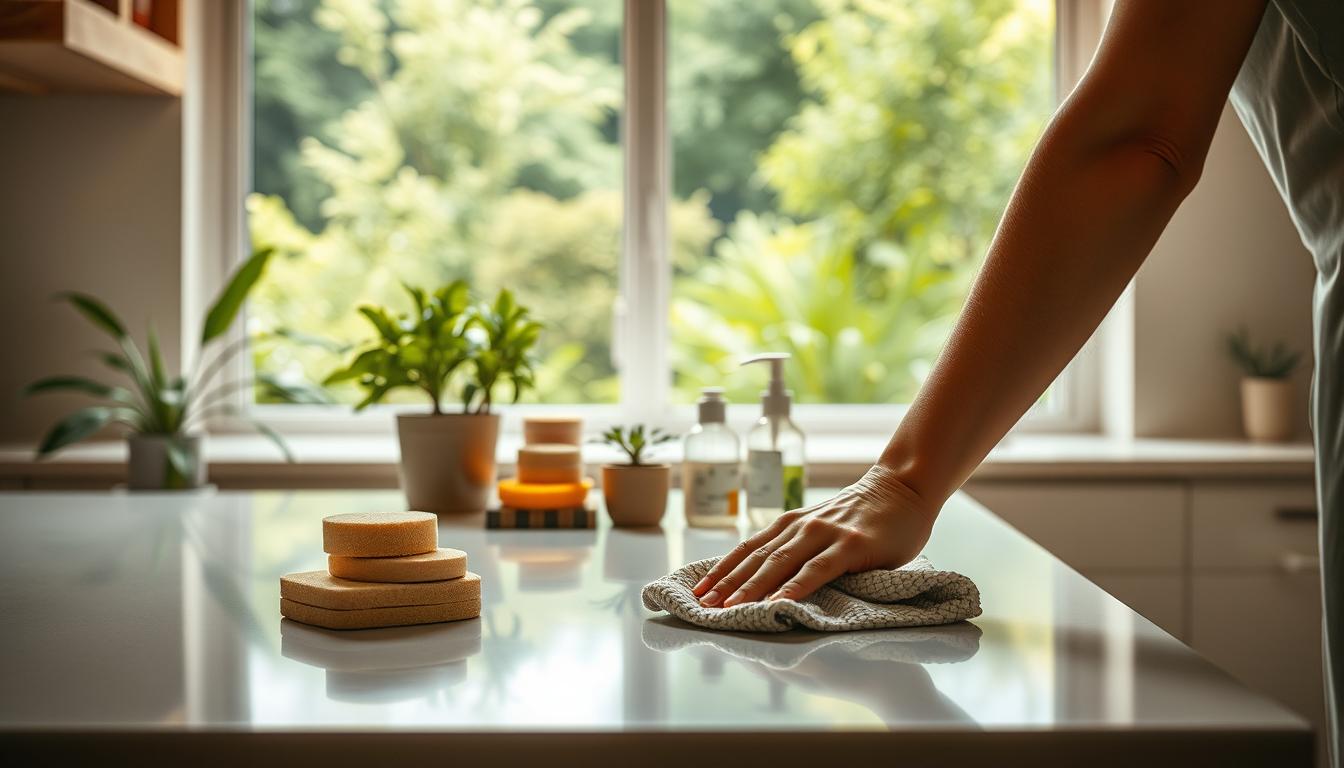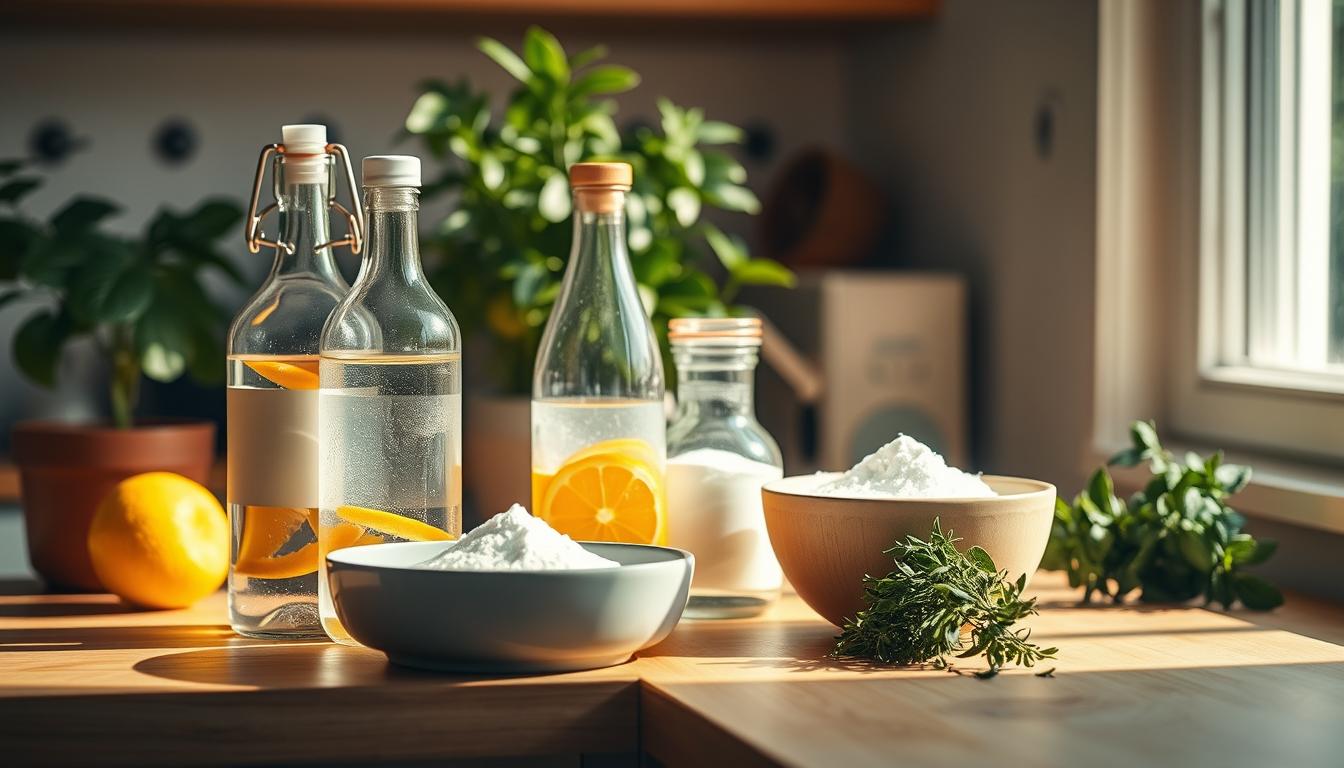Ever felt overwhelmed by clutter at home? What if cleaning could be calming?
Think about tidying up while feeling fully present. Use eco-friendly and mindful cleaning methods that clean and calm. This is mindful cleaning techniques.

Adding sustainable cleaning practices to your day makes your home peaceful. Mindful cleaning means being in the moment. It’s about focusing and letting go of distractions.
Key Takeaways
- Transform cleaning into a meditative experience
- Use eco-friendly cleaning methods for a healthier home
- Incorporate sustainable practices into your daily routine
- Create a peaceful living space through mindful cleaning
- Reduce stress and increase focus with mindful cleaning techniques
The Philosophy Behind Mindful Cleaning
Mindful cleaning makes everyday tasks special. It changes how we see cleaning. It shows that our living space affects our mind and feelings.
Understanding the Connection Between Clean Spaces and Mental Clarity
A clean space helps our minds stay clear. Too much clutter makes us feel lost. But a neat place helps us focus and feel calm.
Leo Babauta says cleaning can be a way to be mindful. It’s about being fully in the moment while we clean.
The Difference Between Mindful Cleaning and Regular Cleaning
Mindful cleaning is different from regular cleaning. It’s about being fully present and aware. It turns cleaning into a special practice.
Adding mindfulness to cleaning makes it a chance for growth and calm. This way of cleaning makes our homes better and our lives more fulfilling.
Mindful Cleaning Techniques for a Transformed Home
Cleaning with care can change your home. Using mindful ways to clean makes tasks special.
Focusing on One Task at a Time
It’s key to focus on one task at a time. This keeps quality high and avoids feeling too much.
The Single-Room Approach
Begin by focusing on one room. This makes you feel proud as you finish each job.
Task Batching for Efficiency
Do similar tasks together, like dusting or vacuuming. This saves time and lessens tiredness.
Practicing Gratitude While Cleaning
Be thankful for what you have and your home. This makes cleaning feel better.
Using All Five Senses in Your Cleaning Practice
Use your senses while cleaning. Notice smells, feel textures, and listen to sounds. This makes cleaning fun.
| Sense | Cleaning Activity |
|---|---|
| Smell | Using natural cleaning solutions like lemon or lavender |
| Touch | Feeling the texture of different surfaces as you clean |
| Sound | Listening to music or nature sounds while you clean |

Creating Your Mindful Cleaning Toolkit
Building a mindful cleaning toolkit means picking the right items. These items should make cleaning easier and better for the planet. This step helps you clean with purpose.
Essential Tools for Effective Cleaning
You’ll need some basic tools that work well and are good for the earth. Here are a few:
- Microfiber cloths for cleaning with or without products
- A long-handled brush for reaching high spots
- A mop with a head you can wash
Selecting Eco-Friendly Cleaning Products
Choosing eco-friendly cleaning products is key. They’re good for the planet and make your home healthier.
What to Look for in Green Cleaning Products
Look for these things in green cleaning products:
| Feature | Description | Benefit |
|---|---|---|
| Biodegradable ingredients | Break down naturally in the environment | Reduces environmental impact |
| Non-toxic formulations | Safe for use around pets and children | Enhances indoor air quality |
| Minimal packaging | Reduces waste and conserves resources | Supports sustainable practices |
Brands That Align with Mindful Values
Here are some brands that care about the planet:
- Seventh Generation: Uses plant-based ingredients and sustainable packaging.
- Ecover: Makes eco-friendly cleaning products with a focus on sustainability.

By picking the right tools and products, you’re cleaning your home and helping the planet.
Establishing a Sustainable Cleaning Routine
Keeping your home clean is good for you and the planet. Using mindful cleaning methods helps keep your home tidy. It also lessens harm to the environment.
Daily, Weekly, and Monthly Cleaning Tasks
It’s key to split cleaning tasks into daily, weekly, and monthly jobs. Daily tasks might be wiping down kitchen counters. Weekly tasks could be deeper cleaning of bathrooms and vacuuming. Monthly tasks might include cleaning out the fridge and dusting ceiling fans.
| Frequency | Tasks |
|---|---|
| Daily | Wipe down kitchen counters, quick pick-up |
| Weekly | Deep clean bathrooms, vacuum |
| Monthly | Clean out fridge, dust ceiling fans |
Adapting Your Routine to Your Lifestyle
Make sure your cleaning routine fits your life. If you’re always busy, use quick and efficient cleaning methods. Using multi-purpose cleaning products can help keep things simple.
Setting Realistic Cleaning Goals
It’s important to set achievable cleaning goals. Break big tasks into smaller ones. Make sure to track your progress.
Tracking Your Progress
Use a cleaning journal or app to keep track of your cleaning tasks and progress.
Celebrating Small Victories

Room-by-Room Mindful Cleaning Approach
Cleaning each room with care makes your home peaceful. This way, you can clean better for each area. It helps make your home a calm place.
Kitchen: The Heart of Mindful Home Maintenance
The kitchen is the heart of the home. Cleaning it mindfully makes cooking better. Start by cleaning high-touch spots.
Countertops and Food Preparation Areas
Use a soft, green cleaner on countertops and where you prepare food. Feel the cloth and smell the cleaner as you clean.
Appliance Care with Intention
Cleaning appliances is special. Think about how they help you every day. For example, cleaning your coffee maker makes mornings better.

Bathroom: Creating a Spa-Like Cleanliness
Make your bathroom a spa. Use natural cleaners that are kind to surfaces and the planet.
Living Areas: Cultivating Peaceful Spaces
In living areas, aim for calm. Dust and vacuum with care. Notice the textures and colors.
Bedroom: Establishing a Sanctuary for Rest
The bedroom is for rest. Clean it to make it calm. Make your bed with care and think about the fabrics.
Using these mindful cleaning tips, you’ll have a cleaner, more peaceful home. It’s all about cleaning with care for each room.
Natural Cleaning Solutions for a Healthier Home
Switching to natural cleaning solutions is easy and good for your home. Using DIY products and avoiding chemicals keeps your space clean and green.

DIY Cleaning Products Using Household Ingredients
Making your own cleaning products saves money and keeps things safe. You can use vinegar, baking soda, and lemon juice to clean well.
Vinegar is great for cleaning. Mix it with water in a spray bottle for a good cleaner.
Benefits of Chemical-Free Cleaning
Not using chemicals makes your home healthier. It’s good for families with kids and pets because it lowers the risk of poisoning.
“The air inside homes can be more polluted than the air outside, largely due to cleaning products and other household chemicals.” – Environmental Protection Agency
Recipes for All-Purpose Cleaners, Disinfectants, and Polishes
Vinegar-Based Solutions
- All-purpose cleaner: Mix 1 cup water, 1 cup white vinegar, and 1 tablespoon baking soda.
- Disinfectant: Use undiluted white vinegar to disinfect surfaces.
Baking Soda Applications
Baking soda is good for cleaning. It scrubs surfaces, absorbs smells, and more.
- Scrubbing powder: Mix baking soda with a small amount of water to form a paste.
- Odor absorber: Place an open box of baking soda in the refrigerator to absorb odors.
Essential Oil Enhancements
Adding essential oils makes cleaning better and smells nice. Tea tree oil is good for fighting bacteria.
Using these natural cleaners keeps your home clean and safe. You won’t have to worry about harsh chemicals.
Decluttering as a Mindful Practice
Decluttering is more than just getting rid of unwanted items. It’s a mindful practice that can make you feel less stressed. By being mindful of our belongings, we can make our living space more peaceful.
The Connection Between Physical Clutter and Mental Stress
Physical clutter can make you feel overwhelmed and anxious. It’s hard to relax in a cluttered home. Studies show that clutter can harm your mental health, making you feel more stressed.

Mindful Decision-Making When Sorting Possessions
When decluttering, think carefully about each item. Ask if it makes you happy or if it’s useful. This conscious cleaning habit helps you choose what to keep and what to throw away.
Responsible Ways to Dispose of Unwanted Items
After deciding what to get rid of, think about how to do it best. Choose environmentally friendly tidying options. This means donating, recycling, or upcycling.
Donation and Recycling Options
Donating to local charities or thrift stores is a great idea. Recycling centers can also handle materials like paper and glass.
Upcycling Possibilities
For items that are good but not needed, upcycle them. This makes old items new and useful again. It also helps reduce waste.
By using these mindful decluttering practices, you can make your space more organized. This supports your overall wellbeing.
Incorporating Mindfulness into Daily Tidying
Make cleaning a calm moment by adding mindfulness to your tidying. It makes cleaning fun and helps the planet too.
The “Clean as You Go” Philosophy
Try the “clean as you go” way to keep your home neat. Clean up right after eating, put things away when done, and keep clutter away. It makes cleaning easier and less stressful.
Turning Cleaning into a Meditation Practice
Make cleaning a meditation by being fully in the moment. Focus on your breath and the feel of your movements. Enjoy the sights and smells of cleaning.
Breathing Techniques While Cleaning
Use deep, steady breathing to stay calm and focused while cleaning. It makes cleaning a peaceful experience.
Finding Flow in Repetitive Tasks
Cleaning can put you in a flow state, where you’re completely in the task. It’s a calm and rewarding feeling.
Seasonal Deep Cleaning with Intention
Every season brings a chance to make your home fresh and clean. Seasonal deep cleaning helps keep your home healthy. It uses eco-friendly cleaning methods and sustainable housekeeping practices.
Spring Cleaning: Renewal and Fresh Starts
Spring is great for opening windows and cleaning. Use natural home cleaning hacks to clean better and be kind to the planet.
Fall Cleaning: Preparing Your Home for Winter Months
Fall is for getting your home ready for winter. Clean gutters, check for drafts, and organize winter clothes.
Making Deep Cleaning Less Overwhelming
Deep cleaning can feel too much. But, there are ways to make it easier.
Breaking Tasks into Manageable Segments
Split big tasks into smaller ones. Clean one room at a time or set aside days for different tasks.
Creating a Seasonal Cleaning Calendar
Make a calendar for cleaning tasks by season. This spreads out the work and keeps your home tidy all year.
Eco-Friendly Laundry and Fabric Care
Using eco-friendly laundry methods helps our planet. Simple changes in your laundry can make a big difference. It’s a great way to live more sustainably.
Mindful Approaches to Washing and Drying
Changing how you wash and dry clothes helps a lot. Washing in cold water and drying clothes outside saves energy. Also, choose eco-friendly laundry detergents without harsh chemicals.
Natural Stain Removal Techniques
Getting rid of stains without chemicals is easy. Use lemon juice and salt for stains. Or make a paste with baking soda and water to apply directly.
| Stain Type | Natural Remedy |
|---|---|
| Grease | Baking soda and water paste |
| Grass | Lemon juice and salt |
Extending the Life of Your Textiles
Proper care of clothes makes them last longer. Wash delicate items gently. Avoid over-drying and store clothes right. This saves money and reduces waste.
Adding these eco-friendly laundry habits to your daily life helps the planet. Remember, “The earth has enough for everyone’s need, but not enough for everyone’s greed.” – Mahatma Gandhi
“The earth has enough for everyone’s need, but not enough for everyone’s greed.”
Mahatma Gandhi
Overcoming Cleaning Challenges Mindfully
Embracing mindful cleaning means more than just new techniques. It’s about finding ways to beat the challenges you face. You’ll meet hurdles like feeling stuck or not having enough time.
Dealing with Cleaning Resistance and Procrastination
Resistance is a big obstacle in mindful cleaning. It’s normal to feel too tired or not want to clean. But, there are ways to overcome this.
Motivation Techniques for When You Don’t Feel Like Cleaning
Setting small goals or rewarding yourself can help. Listening to music or a podcast while cleaning can also make it more fun.
The 10-Minute Rule for Getting Started
The 10-minute rule is very helpful. Start cleaning for just 10 minutes. Often, you’ll keep going after that.
Managing Cleaning with Limited Time
For those with busy lives, time is key. Focus on quick tasks like tidying up or wiping down counters.
Adapting Cleaning Practices for Different Living Situations
Different homes need different cleaning plans. Whether it’s a small apartment or a big house with kids and pets, you need to adjust.
Small Spaces and Apartments
In small places, clutter can grow fast. Use a “one in, one out” rule to keep things balanced.
Homes with Children and Pets
For homes with kids and pets, cleaning together helps. It makes tasks easier and gets everyone involved.
| Cleaning Challenge | Mindful Solution |
|---|---|
| Resistance to Cleaning | Use the 10-minute rule to get started |
| Limited Time | Focus on high-impact, short-duration tasks |
| Clutter in Small Spaces | Implement a “one in, one out” policy |
Conclusion: Embracing Cleaning as a Path to Wellbeing
Exploring mindful cleaning has shown you how simple steps can change your home and improve your wellbeing. By using mindful cleaning techniques daily, you keep your home clean. You also make your living space more peaceful.
Choosing sustainable cleaning practices is key. Using eco-friendly products and cleaning as you go helps the planet. It also makes your home healthier for you and your family.
Mindful cleaning is more than a task. It’s a chance to be mindful, thankful, and take care of yourself. As you keep going, you’ll see benefits beyond a clean home. These include clearer thinking, less stress, and a better life.
By starting these practices, you’re moving towards a more mindful and calm home. Begin your mindful cleaning journey today. See how mindful home cleaning can change your life.
FAQ
What is mindful cleaning, and how does it differ from regular cleaning?
Mindful cleaning means being fully present and focused while cleaning. It uses all your senses and brings gratitude and intention. It’s not just about cleaning. It’s about making a peaceful space that makes you feel good.
How can I start incorporating mindful cleaning techniques into my daily routine?
Start by focusing on one task at a time. Practice gratitude while cleaning. Use all your senses. Begin with simple tasks like washing dishes or wiping down surfaces. Then, move on to bigger tasks.
What are some eco-friendly cleaning products that I can use for mindful cleaning?
Use products made from natural things like vinegar, baking soda, and essential oils. Look for products that are safe for the planet. Brands like Seventh Generation, Ecover, and Method are good choices.
How can I declutter my space in a mindful way?
Be intentional about what you keep and what you throw away. Sort items into groups. Think about the memories and feelings each item brings. Let go of things that don’t bring joy or serve a purpose. Consider donating or recycling them.
What are some natural cleaning solutions that I can make at home?
Make natural cleaners at home with vinegar, baking soda, and lemon juice. Mix equal parts water and white vinegar for a general cleaner. Make a paste with baking soda and water for surfaces.
How can I incorporate mindfulness into my daily tidying routine?
Make cleaning a meditation by focusing on the task. Use breathing exercises to stay present. Try to ignore distractions and focus on the cleaning.
What are some tips for making deep cleaning less overwhelming?
Break big tasks into smaller ones. Make a cleaning plan for the seasons. Clean one area at a time. Get help from family or friends to make it fun.
How can I make my laundry routine more eco-friendly?
Use green laundry detergent. Wash clothes in cold water. Dry them outside instead of using a dryer. Use a clothesline or drying rack to save energy.
What are some strategies for overcoming cleaning resistance and procrastination?
Break tasks into smaller parts. Set achievable goals. Reward yourself for finishing tasks. Try the 10-minute rule to start cleaning.
How can I adapt mindful cleaning practices to my busy lifestyle?
Add small moments of mindfulness to your day. Take deep breaths while cleaning. Find mindfulness in daily activities like commuting or showering.